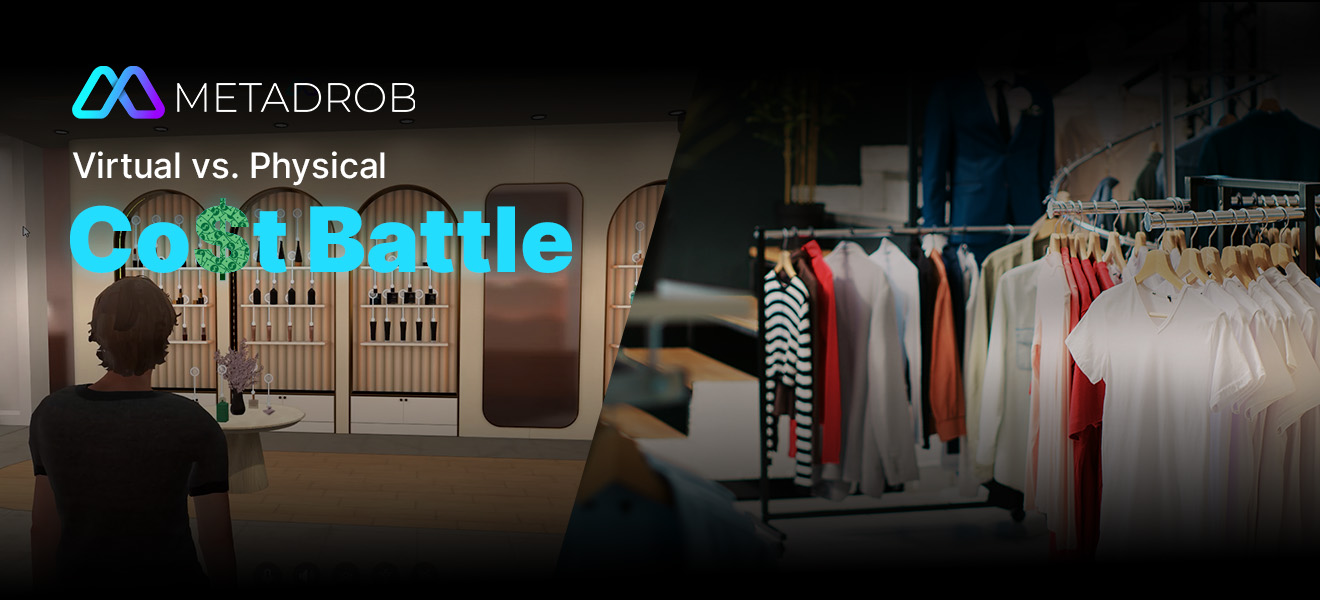What Features Should You Look for in a Virtual Store Platform?

Introduction
The metaverse can be described as the newest trend in the retail industry. With a CAGR growth of 36.7%, the metaverse will grow significantly in the coming years. This space, in which the digital and the real intertwine, represents the only opportunity for firms to revolutionize consumer engagement. The use of immersive technologies may help retailers design exciting, highly personalized and immersive shopping environments.
This article will also teach the reader how the metaverse could revolutionize the retail industry in no time. Also, explore the key features and advantages of shopping in the metaverse, the process of developing immersive experiences, and more. So, let’s start.
Understanding the Metaverse Shopping Experience
Suppose you can shop for apparel virtually, visit a virtual mall, and interact with other customers virtually through your computer. The metaverse will bring this future–or something like this–to shopping. The merging of virtually enhanced physical reality with physically permanent virtual places gives rise to the metaverse—a communal virtual shared area.
When it comes to shopping, it’s a digital world where you can engage with things, explore stores, and make purchases in a really engaging manner.
Key Features of Metaverse Shopping:
- Virtual Showrooms and Product Shows: Visualize buying goods in a virtual shop where products are placed as if in a real shop in a rather interesting manner. This gives you access to a means of exploring and interacting with items that are not available in the real world.
- Dynamic Product Trials and Customizations: You can test furniture, try on clothing, and even personalize items when you buy in the metaverse. Before making a purchase, this interactive experience helps you get a better feel for the product.
- Social Shopping and Community Engagement: The metaverse serves as a social hub for connecting with loved ones, friends, and fellow consumers. Together, you can attend virtual events, have conversations, and exchange recommendations. This makes purchasing more fun and tailored to the individual.
- Gamification and Rewards: To enhance user enjoyment and engagement, numerous metaverse retail platforms integrate gamification features. Incentives, tasks, and other interactive elements that entice you to return can be examples of this.
Benefits of Metaverse Shopping for Retailers:
Here are some key benefits:
Interactive Shopping For Better Decision-Making
- Immersive Experiences: Metaverse purchasing contributes to the creation of product-experience-related brand loyalty since the purchase process allows for more engaging experiences.
- Personalized Shopping: Therefore, by offering customers experiences and products that suit their preferences, the retailers can increase customer satisfaction and, hence, increase their loyalty. As a result, customers can make better decisions.
- Sociable Shopping: Shopping is not a solitary affair; with the help of Metaverse, customers can shop with friends and families and have a good time.
Enhanced Brand Awareness and Reputation
- Virtual Showrooms: Virtual showrooms also enable retailers to showcase their products and brand identity to a wider market, hence improving brand visibility.
- Interactive Events: This is evident in metaverse events such as fashion shows and product launches, where the distinctive feature provides the attendees with excitement.
- User-Generated Content: Metaverse buying experiences can be shared through social media, making the customers’ word-of-mouth advertising cost less to the company.
New Revenue Streams and Opportunities
- Virtual Clothing and Accessories: These are among the virtual products that retailers can sell, while merchants can also provide virtual services such as online consultations.
- Partnerships and Collaborations: This means that brands can collaborate with other companies in the metaverse to attract new clients and obtain new sources of income.
- Data Monetization: Through the customers in the metaverse, the retailers can collect data for specific marketing strategies and sell the data to other parties.
Creating Immersive Metaverse Shopping Experiences
Design and Development Considerations:
User experience (UX) design concepts, technological needs, and integration with current e-commerce platforms must all be carefully considered when developing an immersive metaverse purchasing experience.
- UX Design Principles: Users must have a smooth and simple experience. Make sure there is simple navigation, clear product information, and user-friendly interactions. Think about things like product positioning, checkout procedures, and virtual store layout.
- Technology Prerequisites: To create tremendous experiences, it is necessary to have the right technology. There are three main levels of immersion available: Mixed reality (MR), augmented reality (AR), and virtual reality (VR). AR extends digital onto physical, but VR is even more immersive than AR. MR can be defined as an integration of the virtual and the physical environments. Choose the technology that would best suit your target market and your brand.
- Integration with Current E-commerce Systems: By combining metaverse shopping experiences with current e-commerce systems, businesses may save costs and offer a standardized shopping experience for their customers. Take into account elements such as inventory control, payment processing, and synchronization of product data. The seamless transition between the real and virtual worlds is ensured via a fluid integration.
Product Visualization and Customization:
Imagine being able to customize furnishings to complement your existing decor or trying on a new dress without having to leave your living room. This is the metaverse’s power of product modification and visualization.
- 3D Modeling and Rendering: Shops produce realistic, incredibly detailed 3D models of their merchandise. Customers can now inspect them from every angle, enlarge particular details, and even see how they may seem in various lighting scenarios.
- Interactive Product Configurators: Let customers customize things as they see fit. They can select various colors, materials, and features using interactive configurators, and they can view the results in real time. This degree of personalization has the potential to greatly improve both the shopping and customer experience.
- Try-On Features for Augmented Reality (AR): The digital and physical worlds are connected by AR technology. Customers may digitally try on apparel and accessories and see how they look on their bodies by utilizing an AR glass or smartphone. This offers a more tailored and realistic purchasing experience.
Social Features and Community Building:
Building lively communities around shopping experiences and fostering social relationships are two distinct opportunities presented by the metaverse. Customers can participate, exchange stories, and develop stronger relationships with brands through virtual communities.
Events and live broadcasting can be effective means of igniting excitement and fostering a feeling of community. Retailers engage customers and present their offers dynamically and engagingly by hosting virtual fashion displays, product debuts, and interactive workshops.
Such things as reviews and other user-generated content are critical to building credibility. Customers might feel like they own the store, and therefore, retailers can encourage them to create content, share and even argue.
It also becomes easier to direct product development and employ marketing strategies with the help of user-generated content that provides valuable information to clients.
Future Trends and Innovations in Metaverse Shopping
- Integration with Blockchain Technology: Blockchain technology’s ability to facilitate safe, open, and decentralized transactions means that it has the capability of revolutionizing the metaverse entirely. These are some of the aspects that could be brought about by this: peer-to-peer marketplaces, loyalty programs, and digital ownership of virtual products, among others.
- AI-Powered Personalized Buying Experiences: By evaluating consumer data, artificial intelligence may provide virtual stylists, interactive product guides, and personalized recommendations to improve the metaverse buying experience. This will make the buying experience more interesting and personalized.
- Metaverse Interoperability and Standards: This is especially true as the metaverse becomes a larger part of the everyday social experience, and people will need to transfer between these platforms. This will enable users to have their digital assets on so many devices and also switch from one virtual world to the other. To achieve this, standardized frameworks and protocols must be set up, which will ensure the success of the whole process.
Best Practices for Metaverse Shopping
Creating Engaging and Memorable Experiences:
- Using Immersive Storytelling: Craft a tale that entices readers to enter your metaverse.
- Interactive Elements: Include functions such as virtual try-ons, interactive games, and product personalization.
- Social Features: Encourage a feeling of community through events, social interactions, and content created by users.
- Personalization: Use data analytics to adjust experiences to each person’s preferences.
Measuring and Optimizing Performance:
- Key Performance Indicators (KPIs): Some of the measurable targets include Net promoter scores, the rate of conversion, and the time spent with the clients.
- Customer Feedback: To discover the areas to be addressed by the management, some of the tools that can be used are questionnaires, reviews, and social media posts from the customers.
- A/B Testing: To get the best outcome, you should vary some factors connected with the metaverse purchasing process.
- Continuous Improvement: To remain ahead of trends and satisfy changing customer expectations, update and improve your metaverse often.
Conclusion
So, retailers are in the interesting position that they can actually redefine the way they engage customers through the metaverse. The use of the metaverse can transform the concept of shopping in a retail store through the use of virtual experience centers, engaging tools and experiences.
We may anticipate ever more inventive and customized experiences as technology develops. Retailers who adopt the metaverse will be in a good position to benefit from the expanding trend and create enduring bonds with their patrons.
Deliver Metaverse Shopping Experience To Your Customers Easily With Metadrob By Your Side!
Our platform makes it easier to create interesting and immersive virtual retail environments. You can easily create virtual showrooms, provide interactive product trials, and encourage a sense of community among your clients using Metadrob.
With Metadrob, you’re investing in a future where everyone will have more engaging, fulfilling, and personalized retail experiences rather than just embracing new technology. So, if you want to take a step forward to the future of the metaverse and deliver virtual shopping experiences to customers, now is the time to contact Metadrob. Our next-gen virtual store themes have all the features and functions you seek to boost customer engagement. Book a demo of our virtual store platform today.
Connect with Metadrob
Ready to take the first step towards unlocking opportunities, realizing goals, and embracing innovation? We're here and eager to connect.

+91 966-004-4020







01 Comment
How Metaverse Shopping is Shaping the Future of Retail?,
09 September, 2024[…] can develop virtual stores to deliver the metaverse shopping experiences to boost customer engagement, allow interactive product demonstrations, and offer personalized suggestions, all of which surpass […]
Comments are closed.